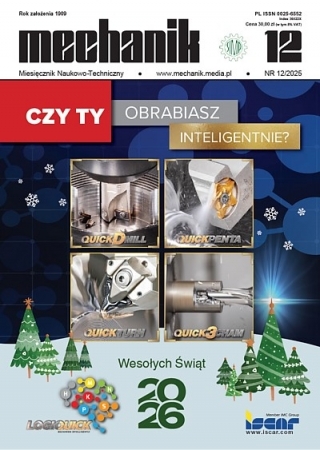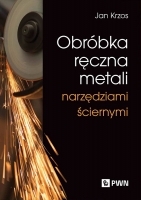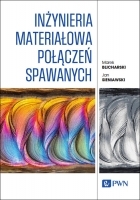Symulacja MES przemieszczania blachy przez próg ciągowy
FEM simulation of sheet movement through the draw bead
Mechanik nr 02/2015 - Artykuły z Międzynarodowego Kongresu CAx Innovation zamieszczone na płycie CD
STRESZCZENIE: W pracy przedstawiono wyniki badań eksperymentalnych oraz symulacji numerycznych badania oporów tarcia blach ze stopu aluminium AA5251 H14. Badania tarcia zostały przeprowadzone za pomocą symulatora progu ciągowego. Wykonano również symulacje numeryczne testu tarcia metodą elementów skończonych w programie MSC.Marc 2010. Symulacje wykonano dla modelu izotropowego materiału określonego kryterium plastyczności Huber- Mises-Henck’y oraz kryteriów anizotropowych plastyczności Hilla (1948) oraz Barlata (1991). Analizowano rozkład naprężeń w przekroju przeciąganej blachy oraz prognozowano numerycznie wartość współczynnika tarcia. Numeryczna analiza symulatora progu ciągowego przedstawiona w pracy umożliwia określenie wpływu modelu anizotropii plastycznej materiału, orientacji próbki orazzjawiska umocnienia odkształceniowego na wartość oporów tarcia.
SŁOWA KLUCZOWE: anizotropia, MES, próg ciągowy, tarcie, współczynnik tarcia, wytłaczanie.
ABSTRACT: The paper presents the results of experimental and numerical simulation studies of frictional resistance of AA5251 H14 aluminium alloy sheets. Friction tests were carried out by using the draw bead simulator. Numerical simulations of a friction test using MSC.Marc 2010 software based on finite element method were also performed. Simulations were carried out for an isotropic material model described by using Huber-Mises-Henck'y yield criterion and anisotropic yield criteria proposed by Hill (1948) and Barlat (1991). We analyzed the stress distribution in the section of pulled sheet and also we numerically predicted the friction coefficient value. Numerical analysis of the draw bead simulator presented in the work allows to determine the effect of plastic anisotropy material model, the orientation of the sample and the strain hardening phenomenon on the value of the resistance to friction.
KEYWORDS: anisotropy, FEM, draw bead, friction, coefficient of friction, stamping.
BIBLIOGRAFIA / BIBLIOGRAPHY:
- Trzepieciński T., Lemu H.G.: Study on frictional conditions of AA5251 aluminium alloy sheets using drawbead simulator test and numerical methods. Strojniški vestnik - Journal of Mechanical Engineering 60 (2014), s. 51-60.
- Gierzyńska M.: „Tarcie, zuŜycie i smarowanie w obróbce plastycznej metali”. Warszawa: WNT, 1983.
- Trzepieciński T.: “Wybrane aspekty oceny tribologicznej blach odkształcanych plastycznie”. Rzeszów: Oficyna Wydawnicza Politechniki Rzeszowskiej, 2013.
- Trzepieciński T.: Analysis of the friction influence on change of surface topography in strip drawing test. Tribologia 44 (2012), s. 125-134.
- Świątkowski K.: Sposoby oceny wielkości tarcia na powierzchniach kontaktu niemetalicznego materiału modelowego i narzędzia. Obróbka Plastyczna Metali 11 (2000), s. 21-30.
- Matuszak A., Kręcisz D.: Badanie oporów przejścia blachy przez progi ciągowe. Obróbka Plastyczna Metali 14 (2003), s. 17-25.
- Kowalik M., Trzepieciński T.: Experimental and numerical study of friction in sheet metal forming processes. Advanced Science Letters 19 (2013), s. 338-341.
- Nine H.D.: Draw bead forces in sheet metal forming. Proceedings of a Symposium on Mechanics of Sheet metal Forming: Behaviour and Deformation Analysis. Plenum Press, Warren 1978, s. 179-211.
- Msc.MARC 2010: Element Library. Santa Ana: Msc. Software, 2010.
- Msc.MARC 2010: Theory and User Information. Santa Ana: Msc. Software, 2010.
- Trzepieciński T.: 3D elasto - plastic FEM analysis of the sheet drawing of anisotropic steel sheet metals. Archives of Civil and Mechanical Engineering 10 (2010), s. 95-106.
- Hollomon J.H.: Tensile deformation. Transactions of AIME 162 (1945), s. 268-290.
- Hencky H.: Zur theorie plastischer deformationen und der hierdurch im material hervorgerufenen nachspannungen. Zeitschrift für Angewandte Mathematik und Mechanik 4 (1924), s. 323-334.
- Huber M.T.: Specific work of strain as a measure of material effort. Archives of Mechanics 56 (2004), s. 173-190.
- Von Mises R.: Mechanik der festen Körper im plastisch-deformablen Zustand. [w:] Nachrichten der königlichen Gesellschaft der Wissenschaften, Mathematisch physikalische Klasse 4 (1913), s. 582-592.
- Hill R.: A theory of the yielding and plastic flow of anisotropic metals. Proceedings of the Royal Society London A193 (1948), s. 281-297.
- Dasappa P., Inal K., Mishra R.: Simulations of forming limit diagrams for the aluminum sheet alloy 5754CC. AIP Conference Proceedings 1252 (2010), s. 972-980.
- Tikhovskiy I., Raabe D., Roters F.: Simulation of earing during deep drawing of an Al–3% Mg alloy (AA 5754) using a texture component crystal plasticity FEM. Journal of Materials Processing Technology 183 (2007), s. 169–175.
- Barlat F., Lege D.J., Brem J.C.: A six-component yield function for anisotropic metals. International Journal of Plasticity 8 (1992), s. 453-476.





















